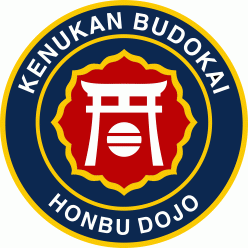By Jim Caldwell – Shin Ryu Kan
The Japanese term Bu-Do 武道 martial way is associated with martial arts such as Karate-Do, Ken-Do, Kobu-Do, Iai-Do, Aiki-Do and Ju-Do. It is sometimes confused with Bushi-Do 武士道 the warrior’s way which is the ancient Japanese Samurai warrior’s code of ethics which dictated his way of life and governed his morals. Bu-Do is a philosophy of training and living and is a guide for attaining self-perfection. To understand the literal meaning of Bu-Do the ideograms that comprise it must be further investigated. The first ideogram or Kanji character Bu 武 is made up with three simple characters Yame 止 stop, Ichi 一 one, and Yoku 弋 piling. Although the Ichi character translates as one in this situation it is probably a horizontal stroke that represents a hand holding a weapon. Possibly the Ka, Hoko 戈 halberd, spear, lance, javelin, arms with one character displaced and a nickname of “tasseled spear” may better represent the literal meaning of Bu. When put together the characters comprising Bu mean stop weapon. Do 道 the way is comprised of two simple characters Shinnyu 辵 / 辶 advancing and Kubi 首 neck. When the two characters which comprise the Do 道 character are put together they mean the way, pathway or road. The characteristics of Do 道 are the following:
- Inseparability of moral theory and ethical practice.
- Are cultural Furyu 風流 elegance.
- The spiritual essence expressed in physical exercise and having an objective character.
- Should not have a “sport aspect.”
- Their aim is peace and amity among nations.
- Are “ways” to be traveled which, though beset with countless difficulties, is wide and manageable for those who will but persist with training made in the prescribed manner.
- System of moral training and ethical practice.
- Egoless (a doctrine that teaches the negation of self or the individual so that he may become one with the universe). This is the doctrine’s essence.
- Focus upon Ri 理 reason and upon Ji 次 particular event.
- Trainee endures hardship that is a companion to frugal living.
- Trainee must become absorbed in Furyu 風流 elegance.
The three mental attitudes for Do 道 for self-improvement are:
- Reigi 礼儀 appreciation and courtesy
- Manzoku 満足 satisfaction
- Judaku 受諾 acceptance
When the Bu-Do 武道 characters are combined they literally mean the way to stop weapon or in an abstract presentation the way to stop conflict.
In ancient times many fighting arts were developed during the course of fighting battles. In Japan during feudal times the country was mired in a series of civil war. War fighting methods eventually developed into Ryuha 流派 styles in association with various fighting methods, various weapon systems and individual. The main purposes of these Ryuha’s were to develop and maintain proficiency in the art of killing and maiming other opponents a Bushi may encounter in battle. Put simply, a study or method of self- protection which became known as Bu-Jutsu 武術 martial arts. Peace ensued over the land during the Tokugawa period of Japanese history for approximately 200 years. There was no need during this time to continue developing technique for war fighting. A transition occurred when the need for self-protection, Jutsu 術, diminished and the need for self-perfection, Do 道, arose thus many of the Ryuha in order for the Bushi to maintain proficiency and to develop the self- made this change. Donn F. Draeger in his Classical Bu-Do states [1] The Bu-Do thus serves as the vehicle of both moral and supra moral education. As such the Bu-Do is considered to be not instruments for killing but vehicles through which individuals can aspire to moral perfection. Though the classical Bu-Jutsu and Bu-Do share a concern for morality, differences in the priority accorded moral acts distinguish them. If the classical Bu-Jutsu and Bu-Do are three dimensional forms, the following priorities hold:
Classical Bu-Jutsu:
- Combat
- Discipline
- Morals
Classical Bu-Do:
- Morals
- Discipline
- Aesthetic form
People study the martial arts for various reasons, some to learn a better self-defense, some for a good exercise program, and some to learn a way of life and to better their selves. Whatever the reason is, if the art that is being studied contains Do 道in its suffix then the course of study is fixed and one should remember the literal translation of Bu-Do, the way to stop weapon, while practicing. While studying any Do 道 art we should all strive to learn ways to stop conflict and develop self-perfection.
- [1]Classical Budo, Donn F. Draeger, Weatherhill, New York & Tokyo, 1973, p36↩
